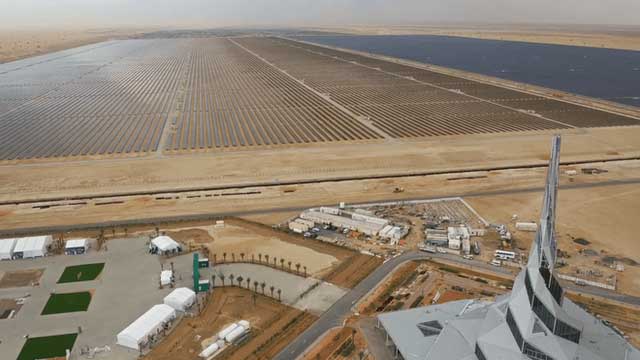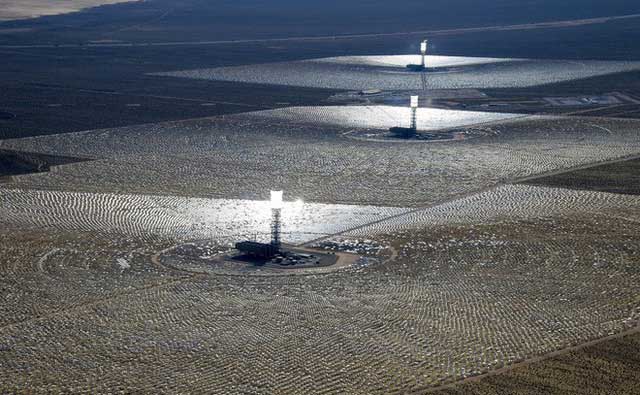Huge solar park between Dubai desert
Deep in the Dubai desert area, Mohammed Bin Rashid Al Maktoum energy park (named after the Emirate of Dubai, and Vice President and Prime Minister of the United Arab Emirates (UAE) is gradually created.
After eight years of construction, satellite images have partly shown the scale of the Mohammed Bin Rashid Al Maktoum Solar Park : the kilometer of photovoltaic panels arranged along the western east, their uniformity contrary to the folds of sand layers around the power plant. After completion, the Dubai Department of Energy & Water (DEWA) confirmed that this 50 billion dirham investment (about US $ 13.6 million) could supply energy to 1.3 million homes, minimizing about 6.5 tons of carbon emissions per year.

The park can power 1.3 million homes, reducing about 6.5 tons of carbon emissions each year.
First published in 2012 and expected to be completed by 2030, this 5,000 megawatt park will have a construction time three times longer than the famous Buri Khalifa building. Phase 1 and 2 were completed, with 2.3 million photovoltaic panels with 213 megawatt capacity. Phase 3 is underway, adding 3 million photovoltaic panels and an additional 800 megawatts of capacity, to be completed by 2020.
After many years across the desert, this energy project is about to enter phase 4 - perhaps the most ambitious development ever. DEWA claims, it will have the world's tallest Solar Absorption Tower (CSP) . It will use mirrors called sun glasses to focus the sun on the top of the tower to melt salt. The heat generated will run steam turbines, producing electricity.

Solar power generation system is located in California.
"Normally, CSP will have a slightly higher performance than photovoltaic," Christos Markides, a professor of clean energy technology at Imperial College London, told CNN. "CSP stores energy in the form of heat rather than in batteries. Storing heat energy is 10 times cheaper than storing electrical energy," he explained. "This brings advantages to that particular technology."
In fact, that means that CSP can continue to generate electricity even without the Sun and at night. Dubai's energy tower can store heat for 15 hours and provide energy 24 hours a day. The CSP tower is 260 meters high when completed and will be surrounded by 70,000 regular glass.

Digital drawing of the Energy Tower at Mohammed Bin Rashid Al Maktoum park.
Besides the 100 megawatt solar power tower, Phase 4 will supply 850 megawatts of electricity through parabolic troughs (another type of solar tower) and photovoltaic. And according to a recent announcement, Phase 5 with 900 megawatts of photovoltaic capacity will start in 2021, while doing other tasks that will help the park reach its final goal of 5,000 megawatts in the right way. plan.
With a capacity of 1,963 megawatts, Mohammed Bin Rashid Al Maktoum Solar Park has named itself on the list of the most powerful solar parks in the world. According to the World Economic Forum, another building in India - Ladakh 3,000 megawatt solar farm will go into operation in 2023. Currently, the desert solar park has a capacity of 1,547 megawatt in Ningxia, China is considered the world's largest active photovoltaic park.


Tengger Energy Park in Ningxia, China.
However, building this huge scale is only part of the story. Resilience to weather conditions and the devastation of time are also core issues.
DEWA said : "Dust is really a big challenge, because dust on the modules can reduce their ability to generate energy." In parallel with the study of photovoltaic coating technology, the government also implemented a "cleaning robot system to make factory books in a short time."
Markides affirms the importance of temperature: "Photovoltaic panels will deteriorate faster if large temperature fluctuations occur, such as being very cold and very hot, or when the temperature becomes extremely hot." In Dubai, the temperature can shift from 40 degrees Celsius to day cold to night.
Dubai 2050's clean energy strategy is aiming to create 25% of energy from clean sources by 2030 and 75% by 2050 - equivalent to a capacity of 42,000 megawatts.
- Costa Rica's largest solar park comes into operation
- Cuba builds many solar parks
- The magnificent cities are buried under the sand of Dubai desert
- Al Fayah - The park is built beneath the desert
- Cruel little facts about Dubai
- Cuba launches solar park
- Cuba operates the second solar park
- Successfully planted saline tolerant rice in Dubai
- The price of solar electricity in Dubai is about one third the price of electricity in Vietnam
- Misunderstandings about Dubai that most people think are true
- The Sahara Desert can turn into a giant power plant
- Build the world's largest underwater park in Dubai
- Cuba built many solar parks
- Desert destroyed: the dark side of the solar manufacturing industry?
 Norway built the world's tallest wooden tower
Norway built the world's tallest wooden tower Kremlin
Kremlin Ashurbanipal: The oldest royal library in the world
Ashurbanipal: The oldest royal library in the world Decoding the thousand-year construction of Qin Shihuang shocked the world
Decoding the thousand-year construction of Qin Shihuang shocked the world